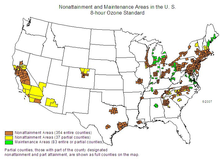
In United States environmental law, a non-attainment area is an area that exceeds pollution limits for one or more criteria pollutants: ozone (O3), atmospheric particulate matter (PM2.5/PM10), lead (Pb), carbon monoxide (CO), sulfur oxides (SOx), and nitrogen oxides (NOx). [1]
Classification
The criteria pollutants and their respective limits are defined in the National Ambient Air Quality Standards, which were a part of the Clean Air Act Amendments of 1970 (P.L. 91-604, Sec. 109). The standards have been updated several times since 1970. [2] The six criteria pollutants in particular are tracked due to their known harmful effects on human health and the environment. [1] An area with outdoor air exceeding the limit for a given pollutant is considered a non-attainment area for that pollutant. An area may be a non-attainment area for one pollutant and an "attainment area" for others. However, these pollutants are frequently associated with each other and thus a non-attainment area typically fails multiple standards. For example, nitrogen oxides and ozone are strongly correlated. [3]
Designation
The Environmental Protection Agency is required to give an area a designation whenever the NAAQS are updated based on whether or not that area meets the new standards using the most recent available data. [1] Current and previous standards are stored in an EPA Green Book for the criteria pollutants. [2] When an area is designed as a non-attainment area, state and local governments with jurisdiction over the area have three years to develop plans for the area to attain the standards. [1]
An area may submit a request for designation as a "reattainment area" after three consecutive years of attaining the EPA's standard for the relevant pollutant(s). [4] If approved, the area will no longer be considered a non-attainment area. However, if at any point the area is shown to no longer be meeting the standard, it is redesignated as a non-attainment area. [4] As a result, areas that are just below the EPA's limit may seek to further lower their pollution levels in order to mitigate the chance of briefly failing the standard and losing their designation as an attainment area. [4]
Current Non-attainment Areas
The EPA maintains a list of non-attainment areas for all criteria pollutants in the United States, classified by county and sorted by state as a part of its Green Book. [5] The Green Book contains data from 1992 to the present and details in which year(s) a county did not attain standards. It provides this information alongside other data such as county population and the severity of the recorded pollution.
As of October 31, 2023, it designates 258 counties as not attaining the standards for at least one pollutant. [5] Since 1992, a total of 2094 counties have been a non-attainment area for at least one pollutant for at least one year.
References
- ^ a b c d US EPA Nonattainment Areas and Designations, U.S. Environmental Protection Agency, Office of Air and Radiation-Office of Air Quality Planning and Standards (Point of Contact), retrieved 2023-11-09
- ^ a b "Nonattainment Areas for Criteria Pollutants (Green Book)". EPA.gov.
- ^ Jaffe, Daniel A.; Ninneman, Matthew; Chan, Hei Chun (2022-06-16). "NO x and O 3 Trends at U.S. Non‐Attainment Areas for 1995–2020: Influence of COVID‐19 Reductions and Wildland Fires on Policy‐Relevant Concentrations". Journal of Geophysical Research: Atmospheres. 127 (11): e2021JD036385. Bibcode: 2022JGRD..12736385J. doi: 10.1029/2021JD036385. ISSN 2169-897X. PMC 9347947. PMID 35942329.
- ^ a b c "DESIGNATION OF AIR QUALITY AREAS". Oregon Secretary of State. Retrieved 2023-11-09.
- ^ a b EPA, US. "Green Book | US EPA". www3.epa.gov. Retrieved 2023-11-25.
 This article incorporates
public domain material from Jasper Womach.
Report for Congress: Agriculture: A Glossary of Terms, Programs, and Laws, 2005 Edition (PDF).
Congressional Research Service.
This article incorporates
public domain material from Jasper Womach.
Report for Congress: Agriculture: A Glossary of Terms, Programs, and Laws, 2005 Edition (PDF).
Congressional Research Service.